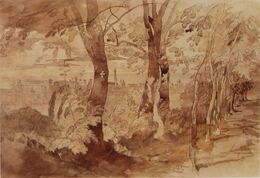Biography:Francesco Maria Zanotti
| Francesco Maria Zanotti | |
|---|---|
| Born | Bologna, Papal States |
| Died | Bologna, Papal States |
Francesco Maria Zanotti Cavazzoni (Bologna, 6 January 1692 – Bologna, 25 December 1777) was an Italian philosopher and writer.[1] Besides being a writer, he was also a commentator on works of art. He was considered an authoritative source on many topics.[by whom?]
Life
He was the son of Giampietro Zanotti, and a pupil of Eustachio Manfredi. In 1718 he became professor of philosophy at the University of Bologna, and in 1723 he was appointed as secretary of Luigi Ferdinando Marsigli. Initially a Cartesian, he became a follower of Newton.[1] In 1728 Francesco Algarotti experimented with light in his lab, replicating the prism and spectrum experiments of Isaac Newton.[2][3] In 1741 he became a Fellow of the Royal Society.[4]
Zanotti's 1741 essay on the 'attractive force of ideas' defended a view of the association of ideas influenced by Newtonian physics. In 1754 Zanotti criticised Pierre-Louis Maupertuis for his views on Stoicism and Christianity, and was drawn into controversy about Stoicism with the Dominican professor Casto Innocenzio Ansaldi.[1]
In 1766 he became president of Institute of Science in Bologna.[5] In 1775 Benjamin Wilson (painter) began a correspondence with Zanotti on phosphor.[6]
Other members of the family
His brother, Giampietro Cavazzoni Zanotti was a Writer, painter, and art historian; Eustachio Zanotti was a famous astronomer and hydraulic engineer.[7][8]
Works
File:Zanotti - De viribus centralibus, 1762 - 4776114 980252 00005.tif
- La forza attrattiva delle idee (1747)
- La filosofia morale secondo i peripatetici (1754)
- Dell'arte poetica (1758)
- Lettere famigliari in difesa della Felsina Pittrice
- Delle lodi delle belle arti
- Dialogo in difesa di G. Reni
- (in la) De viribus centralibus. Bologna: Lelio Dalla Volpe. 1762. https://gutenberg.beic.it/webclient/DeliveryManager?pid=4776114.
References
- ↑ 1.0 1.1 1.2 Garin, Eugenio (2008). History of Italian Philosophy. Rodopi. pp. 719–21. ISBN 978-90-420-2321-5. https://books.google.com/books?id=sVP3vBmDktQC&pg=PA1260. Retrieved 23 September 2012.
- ↑ "THE INSTITUTE OF SCIENCE OF BOLOGNA AND THE ROYAL SOCIETY IN THE EIGHTEENTH CENTURY" by Maria Cavazza. Notes Rec. R. Soc. Lond. 56 (1), p. 10 (2002) [1]
- ↑ Museo Palazzo Poggi
- ↑ "THE INSTITUTE OF SCIENCE OF BOLOGNA AND THE ROYAL SOCIETY IN THE EIGHTEENTH CENTURY" by Maria Cavazza. Notes Rec. R. Soc. Lond. 56 (1), p. 16 (2002)
- ↑ His portrait can be seen here[yes|permanent dead link|dead link}}]
- ↑ "THE INSTITUTE OF SCIENCE OF BOLOGNA AND THE ROYAL SOCIETY IN THE EIGHTEENTH CENTURY" by Maria Cavazza. Notes Rec. R. Soc. Lond. 56 (1), p.16 (2002)
- ↑ "THE INSTITUTE OF SCIENCE OF BOLOGNA AND THE ROYAL SOCIETY IN THE EIGHTEENTH CENTURY" by Maria Cavazza. Notes Rec. R. Soc. Lond. 56 (1), p. 11, 14 (2002)
- ↑ Zanotti, Giampietro Cavazzoni (1745). Vita di Eustachio Manfredi. Lelio dalla Volpe, Bologna. https://books.google.com/books?id=UlZMAAAAcAAJ&q=Giampietro+Zanotti.
External links



